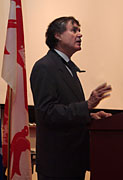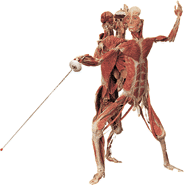Analogue bodies, digital minds
While the French press was agog over Fantaisies cybernétiques, an exhibition featuring dancing, talking robots at the Maison de la culture du Japon in Paris last year, at least one spectator remained underwhelmed. "I thought they were abysmal," says Ian Hacking, chair of Philosophy and History of Scientific Concepts at Collège de France in Paris, and professor emeritus in Philosophy at the University of Toronto. "But underneath these silly humanoids were digital programs, and I saw my catchy title come to life." The catchy title in question: "Analogue Bodies, Digital Minds," and on November 3, Hacking presented the talk that goes with it to a full house at the Charles F. Martin Amphitheatre in the McIntyre Medical Sciences Building. The presentation was the 28th annual Osler Lecture, sponsored by the Faculty of Medicine and the medical students' Osler Society.

Osler lecturer Ian Hacking
Kate Hutchinson
Previous Osler lecturers have included John Kenneth Galbraith, Stephen Gould and John Ralston Saul — illustrious company, but Hacking fits right in. The Vancouver-born philosopher has established himself on the international stage through a series of articles and books ranging across disciplines, including The Social Construction of What?, The Taming of Chance, Mad Travellers and, most recently, Historical Ontology. His talk — a combination history and philosophy lesson of the sort that his readers have come to expect — did not disappoint the audience, taking them on an intellectual trek from Sony's dancing robots through René Descartes' concept of dualism, and on to biomedical engineering and bodily transformation.
These days, Hacking has been thinking about Descartes' famous division of mind and body, which, he argues, is making a comeback within the Western consciousness. Hacking recounted having visited an exhibit of Gunther von Hagens' controversial art piece "Body Worlds" (in which real bodies, flayed but preserved corpses, are set in lifelike poses); a student had written in the guest book "You can really see how the body is different from the mind," and this "young Cartesian," Hacking stressed, is hardly alone. "I suspect we will revert to a Cartesian stance of mind/body, but one which is distinctly grammatical," he said, especially "how we will see ourselves in light of current art and technology." Descartes himself anticipated this particular notion of dualism. In response to a few probing questions from his friend and most astute critic, Elizabeth, the Princess of Bohemia — according to Hacking, "the most intelligent and well-educated woman in Europe" — the philosopher articulated a version of dualism that rested in logic and semantics rather than in substance, and is thus much friendlier to 21st-century minds.

Fencer from Gunther von Hagens' Body Worlds exhibition (www.bodyworlds.com)
As for 21st-century bodies, they have moved ever further away. Hacking follows this trajectory, citing Foucault's history of the objectifying medical gaze as started in the 18th century, and including also the philosophical impact of performance artists such as Orlan, who undergoes surgical procedures regularly to alter her appearance, and Stelarc, who explores the point where human meets machine. As our bodies take on the status of something other than ourselves, Cartesian dualism regains currency. Once relatively stable entities, bodies would change with age, of course, and accident, and occasionally through such methods as tattooing, painting and scarification. But today, the philosopher stressed, we increasingly perceive our bodies as a collection of parts to be bought and sold, removed and replaced, altered and engineered. "The idea of interchangeable body parts works at the level of physical analogues," he argued. "The body accepts inserts." Having recently experienced surgery under a local anesthetic and with a closed-circuit monitor, Hacking has first-hand experience of this encroaching Cartesianism. "Nothing can convince you better of the difference between mind and body than to see one's own organs being re-engineered on television in real time," he observed.
But while the body is becoming increasingly "analogous", the concept of the "digital mind" is slipping toward anachronism. "The digital metaphor was first used when brain science was in its infancy and focused on cognition. We know so much more about the brain now, through MRIs and brain scans, for instance, as well as about the role of emotions, that the metaphor of a digital processor seems very dated." The body may be the analogous "other", but what metaphor will shape our concept of the brain — and the mind — in the latest expression of Cartesian dualism remains an open question.
